
Wool is the textile fibre obtained from sheep and other mammals, especially goats, rabbits, and camelids. The term may also refer to inorganic materials, such as mineral wool and glass wool, that have properties similar to animal wool.

Felt is a textile that is produced by matting, condensing, and pressing fibers together. Felt can be made of natural fibers such as wool or animal fur, or from synthetic fibers such as petroleum-based acrylic or acrylonitrile or wood pulp–based rayon. Blended fibers are also common. Natural fibre felt has special properties that allow it to be used for a wide variety of purposes. "It is fire-retardant and self-extinguishing; it dampens vibration and absorbs sound; and it can hold large amounts of fluid without feeling wet..."
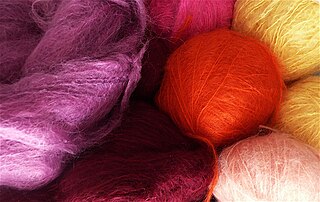
Mohair is a fabric or yarn made from the hair of the Angora goat. Both durable and resilient, mohair is notable for its high luster and sheen, and is often used in fiber blends to add these qualities to a textile. Mohair takes dye exceptionally well. It feels warm in winter as it has excellent insulating properties, while its moisture-wicking properties allow it to remain cool in summer. It is durable, naturally elastic, flame-resistant and crease-resistant. It is considered a luxury fiber, like cashmere, angora, and silk, and can be more expensive than most sheep's wool.

Extreme cold weather clothing refers to clothing for arctic or mountainous areas. Its primary function is to trap air as an insulator to prevent heat loss from the wearer's body. Secondary and necessary is to conduct water vapor away from the body to keep the insulating layers dry. A shell keeps the wind from disturbing the still air in the insulating layers. In warmer conditions, the shell protects from water intrusion.

A Labradoodle is a crossbreed dog created by crossing a Labrador Retriever and a Standard or Miniature Poodle. The term dates back to at least 1955 but was unpopular at the time. Labradoodles are considered a good choice for people with canine dander allergies, since some have the same hypoallergenic coat as their poodle ancestors.

Coat is the nature and quality of a mammal's fur. In the animal fancy, coat is an attribute that reflects the quality of a specimen's breeding as well as the level of the animal's care, conditioning, and management. Coat is an integral aspect of the judging at competitions such as a conformation dog show, a cat show, a horse show, or a rabbit show.
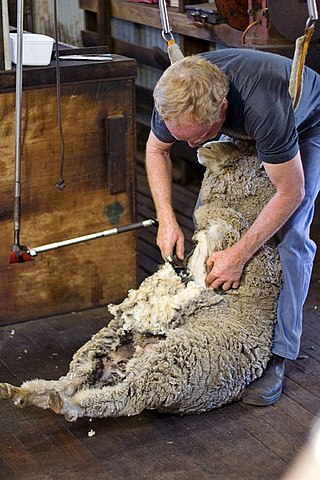
Sheep shearing is the process by which the woollen fleece of a sheep is cut off. The person who removes the sheep's wool is called a shearer. Typically each adult sheep is shorn once each year. The annual shearing most often occurs in a shearing shed, a facility especially designed to process often hundreds and sometimes more than 3,000 sheep per day.

The Soay sheep is a breed of domestic sheep descended from a population of feral sheep on the 100-hectare (250-acre) island of Soay in the St Kilda Archipelago, about 65 kilometres (40 mi) from the Western Isles of Scotland. It is one of the Northern European short-tailed sheep breeds.

A horse blanket or rug is a blanket or animal coat intended for keeping a horse or other equine warm or otherwise protected from wind or other elements. They are tailored to fit around a horse's body from chest to rump, with straps crossing underneath the belly to secure the blanket yet allowing the horse to move about freely. Most have one or two straps that buckle in front, but a few designs have a closed front and must be slipped over a horse's head. Some designs also have small straps that loop lightly around the horse's hind legs to prevent the blanket from slipping sideways.
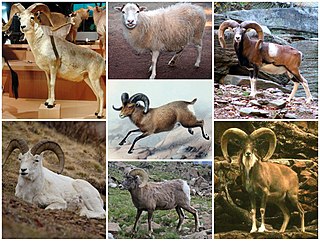
Ovis is a genus of mammals, part of the Caprinae subfamily of the ruminant family Bovidae. Its seven highly sociable species are known as sheep or ovines. Domestic sheep are members of the genus, and are thought to be descended from the wild mouflon of central and southwest Asia.

Sheepskin is the hide of a sheep, sometimes also called lambskin. Unlike common leather, sheepskin is tanned with the fleece intact, as in a pelt.

Animal fibers are natural fibers that consist largely of certain proteins. Examples include silk, hair/fur and feathers. The animal fibers used most commonly both in the manufacturing world as well as by the hand spinners are wool from domestic sheep and silk. Also very popular are alpaca fiber and mohair from Angora goats. Unusual fibers such as Angora wool from rabbits and Chiengora from dogs also exist, but are rarely used for mass production.

The Shetland is a small, wool-producing breed of sheep originating in the Shetland Isles, Scotland, but is now also kept in many other parts of the world. It is part of the Northern European short-tailed sheep group, and it is closely related to the extinct Scottish Dunface. Shetlands are classified as a landrace or "unimproved" breed. This breed is kept for its very fine wool, for meat, and for conservation grazing.

The raising of domestic sheep has occurred in nearly every inhabited part of the globe, and the variations in cultures and languages which have kept sheep has produced a vast lexicon of unique terminology used to describe sheep husbandry.

Alpaca fleece is the natural fiber harvested from an alpaca. There are two different types of alpaca fleece. The most common fleece type comes from a Huacaya. Huacaya fiber grows and looks similar to sheep wool in that the animal looks "fluffy". The second type of alpaca is Suri and makes up less than 10% of the South American alpaca population. Suri fiber is more similar to natural silk and hangs off the body in locks that have a dreadlock appearance. While both fibers can be used in the worsted milling process using light weight yarn or thread, Huacaya fiber can also be used in a woolen process and spun into various weight yarns. It is a soft, durable, luxurious and silky natural fiber.

The Salish Wool Dog or Comox dog is an extinct breed of white, long-haired, Spitz-type dog that was developed and bred by the Coast Salish peoples of what is now Washington state and British Columbia. The small, long-haired wool dog and the coyote-like village dogs were deliberately maintained as separate populations. The dogs were kept in packs of about 12 to 20 animals, and fed primarily raw and cooked salmon. To keep the breed true to type and the preferred white color, Salish Wool Dogs were confined on islands and in gated caves.

Sheep or domestic sheep are a domesticated, ruminant mammal typically kept as livestock. Although the term sheep can apply to other species in the genus Ovis, in everyday usage it almost always refers to domesticated sheep. Like all ruminants, sheep are members of the order Artiodactyla, the even-toed ungulates. Numbering a little over one billion, domestic sheep are also the most numerous species of sheep. An adult female is referred to as a ewe, an intact male as a ram, occasionally a tup, a castrated male as a wether, and a young sheep as a lamb.
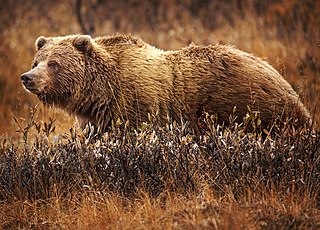
Fur is a thick growth of hair that covers the skin of mammals. It consists of a combination of oily guard hair on top and thick underfur beneath. The guard hair keeps moisture from reaching the skin; the underfur acts as an insulating blanket that keeps the animal warm.

The history of the domestic sheep goes back to between 11,000 and 9,000 BC, and the domestication of the wild mouflon in ancient Mesopotamia. Sheep are among the first animals to have been domesticated by humans. These sheep were primarily raised for meat, milk, and skins. Woolly sheep began to be developed around 6000 BC. They were then imported to Africa and Europe via trading.
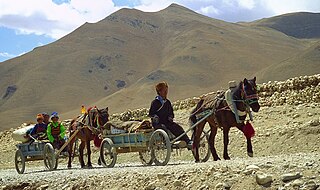
Human uses of mammals include both practical uses, such as for food, sport, and transport, and symbolic uses, such as in art and mythology. Mammals have played a crucial role in creating and sustaining human culture. Domestication of mammals was instrumental in the Neolithic development of agriculture and of civilisation, causing farming to replace hunting and gathering around the world, and cities to replace scattered communities.






















